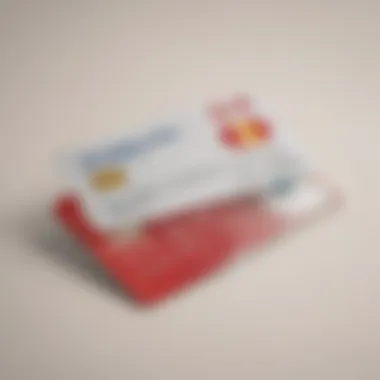Using Debit Cards for MoneyGram Transactions Effectively


Intro
Navigating the world of financial transactions has become increasingly multifaceted. With the rise of digital banking and payments, understanding various platforms and their uses can be a game changer in your financial dealings. In this analysis, we embark on an exploration of using debit cards for MoneyGram transactions. Understanding the frameworks surrounding this process is crucial for effectively managing your money.
MoneyGram stands as one of the prominent players in the global money transfer market, offering services that are speedy and reliable. Using a debit card can simplify the process for many, allowing funds to move quickly without the need for cash or checks. However, not all is cut and dried. There are intricate details about policies, benefits, and potential pitfalls of utilizing a debit card for such transactions that must be weighed.
"The most critical aspect of any financial transaction is understanding the terms and implications. Only then can users ensure that their transactions are secure and efficient."
As we develop this analysis, we will touch on the operational dynamics of MoneyGram, the acceptance of debit cards, consider the pros and cons of the approach, and provide a roadmap for users. Those looking to enhance their understanding of this can delve deep into strategies that may serve both their immediate and future financial needs.
Having a solid grasp of financial terminology will not only empower users in their transactions but also offer clarity amidst the complexities of money exchange. Let's turn our attention to a vital aspect of this discussion—Investment Dictionaries.
Understanding MoneyGram as a Service
MoneyGram plays a significant role in the landscape of money transfers, making global transactions accessible for people from all walks of life. Its availability in many countries and continuous effort to improve user experience makes it a popular choice for sending and receiving money. For those considering utilizing debit cards for these transactions, understanding MoneyGram's framework is crucial. Knowing how it operates helps consumers make informed decisions about their financial transactions, ensuring they harness its full potential.
On a broader scale, MoneyGram has revolutionized how people manage their finances, often serving as a lifeline in urgent situations where time is of the essence. The convenience of using a debit card fits perfectly into the fast-paced world we live in. This article seeks to explore these elements, diving deep into how MoneyGram can be used effectively alongside debit cards.
Overview of MoneyGram
Founded in 1940, MoneyGram has grown to become one of the largest money transfer services globally. It allows users to send and receive funds across borders with ease. Its operations are facilitated through a vast network of agents, retail outlets, and online platforms, ensuring accessibility for everyone, from students studying abroad to families supporting loved ones in different countries.
Unlike banks that might have complex procedures, MoneyGram simplifies the money transfer process. Users can complete transactions within minutes, facilitating both domestic and international payments. This ease of use makes it favorable for individuals needing quick access to funds. The company has also made strides toward improving its digital offerings, allowing transactions via mobile apps and websites.
Purpose of MoneyGram Transactions
The primary purpose of MoneyGram transactions is to facilitate the swift movement of funds. Whether it's to support family back home, pay for education, or settle a bill, the platform provides a convenient way to send money securely.
- Global Reach: MoneyGram has a notable presence worldwide, enabling users to send money to regions where traditional banking services may not be available. This becomes crucial in emergencies or when family members are in need.
- Speed: In many cases, the urgency of funds transfers cannot be overstated. MoneyGram transactions are often instantaneous, minimizing wait times and making it easier for families to support each other.
- Flexibility: Whether you're using cash, a debit card, or even a credit card, MoneyGram accommodates a variety of payment methods. The ability to use multiple payment options enhances accessibility, as users can choose the method that works best for them.
Various factors contribute to the growth and popularity of using MoneyGram for transactions. As we aim to explore the integration of debit cards into this system, understanding the foundations of MoneyGram will serve as a stepping stone to uncovering its capabilities and the efficiencies it offers in day-to-day financial interactions.
Debit Card Fundamentals
When it comes to financial transactions, understanding the role of debit cards is crucial, especially in the context of using services like MoneyGram. Debit cards serve as a bridge between your bank account and various payment platforms, enabling seamless money transfers. Grasping the fundamentals helps users make informed choices, ensuring they navigate their transactions efficiently and securely.
What is a Debit Card?
A debit card is a plastic card issued by a bank that allows users to access funds directly from their checking account to make purchases or withdraw cash. Unlike credit cards, which extend a line of credit, debit cards draw money directly from the user's bank balance. This means that when you swipe your debit card at a store or online, the amount spent is immediately deducted from your account, keeping spending in check and avoiding debt accumulation.
Key features of debit cards include:
- Direct Access to Funds: Debit cards provide users a straightforward way to pay for goods and services without relying on borrowed money.
- ATM Withdrawals: They often come with the added benefit of allowing users to withdraw cash from ATMs, giving them quick access to their funds.
- Low or No Fees: Many banks offer debit cards with minimal or no annual fees, which can make them a cost-effective option for everyday transactions.
Distinctions Between Debit and Credit Cards
Understanding the key differences between debit and credit cards is vital for making strategic financial decisions. Here’s a breakdown:
- Source of Funds: Debit cards pull directly from your bank account, while credit cards allow you to borrow money up to a certain limit.
- Debt Liability: Using a debit card eliminates the risk of accruing debt, as you can only spend what you have. With credit cards, overspending can lead to interest charges and potential debt traps.
- Rewards and Perks: Credit cards often come with rewards programs, cashback offers, and travel benefits, which are generally not found with debit cards.
- Impact on Credit Score: Responsible credit card use can help build your credit profile, but debit card activity does not influence your credit score.
In summary, while both types of cards have their equal share of benefits, they cater to different spending habits and financial goals. The choice ultimately depends on what suits your lifestyle best.


"Knowing the difference between debit and credit cards is like having a roadmap for your finances; it can guide you to avoid pitfalls and reach your financial destination."
Understanding these fundamentals sets the stage for deeper discussions about using debit cards for MoneyGram transactions and the practical steps involved.
Integrating Debit Cards with MoneyGram
In the modern age of digital finance, the ability to utilize debit cards for services such as MoneyGram is crucial for streamlining money transfers. This section dives into the significance and practicality of integrating debit cards with MoneyGram, and why it matters to users wanting to enhance their transaction experience.
The integration of debit cards with MoneyGram offers a range of benefits that facilitate quicker transactions. For many customers, switching to a debit card can simplify funds transfer, providing a sense of security compared to carrying cash. Additionally, the nature of debit transactions inherently enforces fiscal discipline — customers can only spend what is available in their accounts, which is a pivotal feature for those managing budgets.
Can You Use a Debit Card for MoneyGram?
Yes, using a debit card for MoneyGram transactions is not only possible but has become a preferred method for many customers. When customers initiate a transfer, during the process, they often encounter an option for entering debit card details. This convenience is part of a larger trend wherein digital payment methods are gaining popularity due to their speed and ease of use.
For someone wanting to send money quickly, choosing a debit card means the transfer is processed almost instantly, which can be vital in urgent situations. It’s also beneficial to know that unlike cash transactions, using a debit card can help maintain a digital record of transfers, which is useful for tracking finances.
Moreover, some users may find that they receive notifications on their bank statement, allowing them to keep tabs on outgoing funds. As an added layer of convenience, most debit cards enable users to link directly to their checking accounts, meaning that the transfer amount is deducted with minimal effort. Should a customer face issues, many banks offer real-time customer service to address concerns related to debit card authentication during transactions.
Accepted Debit Cards by MoneyGram
MoneyGram has a flexible policy when it comes to accepted debit cards, but it’s essential to recognize which cards are supported prior to making any transactions. Primarily, most major debit card providers are accepted. These include:
- Visa Debit: Arguably one of the most commonly used, it provides worldwide acceptance.
- MasterCard Debit: Similar breadth of acceptability; widely recognized and trusted.
- American Express Debit: Less common but still valid in many regions.
- Discover: Often accepted, but its reach can be limited compared to Visa and MasterCard.
Before proceeding, customers should check with their bank regarding any limitations or specific conditions tied to their debit cards. It's always a wise move to ensure that the card is in good standing, as any blocks on the card due to insufficient funds or account issues will inevitably lead to transaction failures.
Additionally, it’s valuable to note that some regions might have particular restrictions based on partnership agreements between MoneyGram and local banks. Thus, confirming accepted cards before initiating a transfer will spare customers unnecessary confusion and potential delays.
“Understanding which debit cards are accepted by MoneyGram not only makes transactions smoother but also enhances user confidence in conducting transfers.”
This section serves to empower users with the knowledge necessary to make fully informed decisions, cultivating a smoother experience in their financial transactions.
Benefits of Using Debit Cards for MoneyGram Transactions
Using a debit card for MoneyGram transactions brings several crucial benefits that can enhance the user experience. As people seek speedy and efficient ways to send and receive money, having a connection between debit cards and MoneyGram can be quite advantageous. This connection allows users to tap into the convenience of debit cards while enjoying the services MoneyGram provides. The following areas will highlight the significance of using debit cards for MoneyGram transactions, focusing on fast transactions and cost-effectiveness.
Advantages of Fast Transactions
In today’s world, speed often reigns supreme. When it comes to money transfers, the ability to conduct transactions swiftly can play a vital role in many individuals’ financial requirements. With MoneyGram, using a debit card can facilitate near-instant transfers. Here’s how:
- Instant Access: When you send money using a debit card, funds can be accessed almost immediately by the receiver, whether they’re in another country or just across town.
- Smooth Process: Transaction processes are typically streamlined, meaning less time spent navigating complex systems or dealing with paperwork.
- 24/7 Availability: Debit card transactions can be executed any time of the day. Whether it’s 3 AM or 3 PM, you can send money without worrying about bank hours.
"In an era where time is money, benefiting from fast transactions can make all the difference for users relying on MoneyGram."
Additionally, users don’t have to wait for funds to clear, as debit card payments tend to settle quicker than other modes of payment, such as checks or even some credit card transactions. This immediacy makes debit cards particularly appealing for users needing money transfers to reach the receiver without unnecessary delays.
Cost-Effectiveness of Debit Transactions
Another significant aspect of utilizing debit cards for MoneyGram transactions is cost-effectiveness. In times when financial security is at the forefront of many minds, minimizing costs can lead to better money management. Here’s how good ol’ debit cards stack up in terms of expenses:
- Lower Fees: Usually, the transaction fees associated with debit card payments are lower than those for credit card transactions. This is particularly advantageous for frequent users or larger amounts.
- No Interest Charges: Unlike credit cards, debit cards do not incur interest fees. Users can effectively send money without worrying about accruing debt, making budgeting much more straightforward.
- Transparent Costs: When using a debit card, users often enjoy clearer fee structures than credit card transactions, where hidden fees can apply. Debit card transactions tend to have more direct pricing, so individuals know what they’re getting into.
Overall, choosing a debit card for MoneyGram not only speeds up the transaction process but can also save users money in the long run. In a financial landscape where every cent can count, these benefits can significantly enhance the customer experience and promote smarter financial choices.


Limitations and Considerations
When discussing debit cards for MoneyGram transactions, it’s crucial to consider the limitations that can affect users. Understanding these constraints not only helps in making informed decisions but also prepares users for the potential hurdles they might encounter. This section aims to shed light on two key areas: potential fees involved and transaction limits on debit cards.
Potential Fees Involved
Using debit cards for MoneyGram transactions may not always be free from charges. While many financial services tout convenience, users should keep an eye out for possible fees that can be tacked onto transactions. Here are some important points to keep in mind about fees:
- Service Charges: MoneyGram may apply service fees depending on the transaction amount and destination. These costs can vary significantly. So, knowing these can save you a few bucks—nothing worse than a surprise at checkout!
- Bank Fees: Don’t forget that your bank might also charge fees for using your debit card for this service. It could include international transaction fees if you’re transferring money overseas. It may feel like being hit from both sides!
- Conversion Fees: If your funds need conversion from one currency to another, expect to bear some conversion fees. Some banks charge hefty rates for converting currencies, which can really add up, especially on large transfers.
"It’s wise to read the fine print! Understanding fees beforehand can help avoid unwelcome surprises when you complete your transaction."
Users should always check with MoneyGram and their bank before embarking on a transaction. Understanding the entirety of potential costs enables smarter financial maneuvers.
Transaction Limits on Debit Cards
Another key consideration is the transaction limits imposed on debit cards. While debit cards give you the convenience of accessing funds directly, they often come with restrictions that could hinder larger transfers. Key points regarding transaction limits include:
- Daily Limits: Many banks set daily limits for how much money you can withdraw or send via debit cards. This can be restrictive, particularly for consumers needing to send larger amounts. It’s like being held back at the starting line while the race is on!
- Transaction Size: MoneyGram itself may impose limits on the maximum amount per transaction based on factors like your location, currency, and transfer type. These limits are meant to protect against fraud, but they can also catch you off-guard if you’re not informed.
- Account Type: Different types of debit accounts may have various limitations. For instance, a student account might have looser limits compared to a standard checking account. Awareness of your account's specifics can significantly influence your strategy for sending money.
Understanding these limitations and fees makes a world of difference in planning your transactions. A little bit of foresight can save both time and money down the road, ensuring smoother financial dealings.
Practical Steps to Use a Debit Card with MoneyGram
Understanding how to use a debit card with MoneyGram is crucial for those who prefer a straightforward, budget-friendly method of transferring money. This section aims to demystify the process of utilizing a debit card within the MoneyGram framework. By following these practical steps, users can ensure seamless transactions while maintaining financial oversight. It’s all about clarity and efficiency—without breaking the bank.
Initiating a Transfer
The first step in any MoneyGram transaction is the initiation of the transfer. This stage is pivotal as it sets the entire process into motion. Users have various options to start a transfer, including using an app or visiting a physical MoneyGram location. When choosing to use your debit card for a transfer, ensure you know exactly how much money you want to send and the exchange rates that may apply, especially if you are sending money internationally.
- Select Transfer Type: Whether you’re sending domestic or international funds, clarity about transaction types helps; some may require documentation or identification.
- Choose Your Recipient: You’ll need basic details about the receiver. This could be a person or a business—the clearer, the better.
- Verify Your Location: If you're at a physical outlet, ensure you’re in the right place right from the start. Double-check signage for MoneyGram services.
Overall, this initiating phase is the groundwork; without it, the rest stands on shaky ground.
Inputting Debit Card Details
Once you’re ready to roll, the next logical step is to input your debit card details. This part may seem simple but demands attention. Accuracy is key here because even a minor mistake can derail your payment or lead to delays.
- Card Number and Expiry Date: Ensure you type your card number correctly. The expiry date is equally crucial; using an expired card is a common pitfall.
- Security Code: The three-digit CVV on the back of the card is a security measure—don’t skip this part!
- Billing Address: MoneyGram might require the billing address linked with your debit card. This precaution protects both parties from fraud.
It’s worth noting that some people might hesitate about entering such sensitive information. But MoneyGram employs encryption, working hard to safeguard your data.
Confirmation of the Transaction
After entering all your details, the final piece of the puzzle is the confirmation of the transaction. This step serves as the safety net ensuring you know your money is on the move.
- Review Transaction Details: Go through all entered information meticulously. Confirm the amount, recipient, and payment method.
- Receive Transaction Reference: After you’ve confirmed everything, expect a transaction reference number. Keep this for your records; it’s your ticket to tracking the transaction.
- Digital Confirmation: Depending on how you initiated the transfer, you might also receive an email or app notification confirming the transaction.
The confirmation phase not only reassures you that the transfer has taken place but also provides peace of mind should any issues arise later on.
Alternative Payment Options through MoneyGram


Using MoneyGram for transactions is not just confined to debit cards. It's vital to explore alternative payment options for a holistic understanding of the service. This can open doors for users who prefer different methods of paying, especially if they encounter situations where using a debit card is not possible or convenient.
One significant advantage of considering alternative payment options is flexibility. Different users have different preferences and situations that dictate which payment method is ideal for them. Some may prioritize security, whereas others might focus on transaction speed. By examining the alternatives, users can position themselves to make informed decisions that best suit their individual financial needs.
Let’s take a look at two popular alternatives:
Using Credit Cards
Credit cards can serve as a viable alternative for making MoneyGram transactions. Many people are accustomed to using credit cards for a variety of purchases due to their convenience and added perks like cash back or rewards points. When opting for a credit card, users benefit from the ability to make larger transactions without immediately impacting their available cash balance. Some users appreciate the security features offered by credit cards, such as fraud protection, which can offer peace of mind while transacting.
However, there are some hurdles. It’s crucial to stay mindful of overspending that can lead to interest charges if the balance isn’t paid off in full. Moreover, not all credit cards may be accepted for MoneyGram transactions, so verifying this in advance is a smart move. Additionally, credit card transactions may incur fees which could add up over time.
Direct Bank Transfers
Direct bank transfers through MoneyGram represent another alternative worth considering. This method allows individuals to move money directly from their bank account to the recipient’s account, which can be especially useful for larger sums. One notable benefit is that users often avoid the potential fees associated with cards, both credit and debit. This could lead to a more cost-effective solution if the transfer involves significant amounts.
One downside, however, can be the duration of the transfer. Unlike the instant nature of a debit or credit card transaction, bank transfers may take longer to process, sometimes due to interbank policies or weekends. Hence, if time is of the essence, this option may not be the best fit. Furthermore, the user needs to ensure they have all correct details, such as account numbers, to avoid any hitches in the transfer.
In summary, while debit cards stand out for their fast and cost-effective nature, understanding these alternative payment options enriches the experience with MoneyGram. In the world of finance, being equipped with knowledge allows individuals to navigate it effectively, ensuring they make the best choices according to their circumstances.
Security Considerations
In today's fast-paced financial landscape, security considerations hold paramount importance, particularly when engaging in money transfer services like MoneyGram. With an increasing number of online transactions, it’s crucial to prioritize secure methods for sending and receiving funds. Understanding the vital aspects of security not only safeguards your finances but also enhances peace of mind during transactions.
When using a debit card for MoneyGram transactions, various elements come into play to ensure safe dealings. One of the foremost benefits of using debit cards is that they often come with built-in fraud protection features. These protections can create a buffer against unauthorized access and fraudulent activities, making it less likely for your funds to disappear into the ether.
However, while the safeguards offered by financial institutions can be reassuring, relying solely on them isn’t enough. Customers must cultivate a proactive approach to security, keeping themselves informed and vigilant during their transactions.
Ensuring Safe Transactions
To ensure safe transactions when using a debit card for MoneyGram, it is critical to adhere to best practices. Here are a few key points to consider:
- Use Trusted Networks: Always transact over secured networks. Avoid public Wi-Fi for sensitive financial activities. If you must use a public connection, consider using a VPN to enhance your security.
- Transaction Limits: Check any transaction limits on your debit card. Setting limits can prevent large amounts from being siphoned off without your knowledge.
- Monitor Your Account: Regularly check bank statements and transaction summaries. Early detection of unauthorized transactions can be the difference between a minor inconvenience and significant financial loss.
As simple as these practices may sound, they form the backbone of effective transaction security. By enacting these measures, users can significantly mitigate risks.
Protecting Personal Information
Aside from ensuring secure transactions, protecting personal information is another critical aspect of financial security. Here are several strategies to minimize risks associated with personal data exposure:
- Strong Passwords: Create complex passwords that resist easy guessing. Avoid reusing passwords across multiple platforms.
- Two-Factor Authentication: Activate two-factor authentication (2FA) wherever available. This adds an extra layer of security by requiring additional verification steps.
- Be Historical: Be cautious about sharing personal information. To avoid unintentional leaks, think before sharing sensitive details over unsecured channels.
"The best defense is a good offense." When it comes to protecting your personal information, a proactive approach is necessary.
Practicing these habits can not only protect your individual transactions but can also contribute to a broader culture of security within financial platforms. Proper understanding and implementation of these guidelines are paramount for anyone looking to navigate the world of MoneyGram with a debit card securely.
The End and Final Thoughts
In wrapping up our discussion about the utilization of debit cards for MoneyGram transactions, it becomes quite clear that the intersection of these two financial tools holds significant relevance for users seeking efficient ways to manage their money transfers. The insights provided throughout this article underscore the importance of understanding the operational nuances of MoneyGram while also being well-acquainted with how debit cards function within this ecosystem.
Using a debit card for MoneyGram transactions offers a streamlined approach that combines the familiarity of electronic payments with the reach of a global money transfer service. This method not only provides speed but also enhances convenience, particularly for users who may not have access to traditional banking methods.
Moreover, it’s crucial to consider the potential drawbacks associated with this approach. While debit card transactions can be more economical than credit cards in terms of fees, users must be vigilant about transaction limits and the potential for hidden fees. Understanding these elements can help users make informed decisions, preventing any unwelcome surprises when initiating transfers.
Benefits and Considerations
- Ease of Use: Navigating the process of sending money has never been easier for users who are comfortable with debit card operations.
- Cost-Effectiveness: The ability to manage funds directly from a debit account can avoid the accruement of debt associated with credit use.
- Safety: Transactions using debit cards come with their own set of security protocols, although users must remain proactive in safeguarding their personal information.
Ultimately, grasping the practical aspects and commercial applications of using debit cards with MoneyGram equips users with the tools they need to optimize their financial transactions. Armed with the knowledge presented in this article, individuals can approach future money transfers with clarity and confidence.







